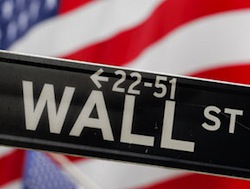A plunge protection fund is a strategic reserve – usually cash – that you set aside to deploy in periods of market panic.
This is not an official investing term. Indeed, Google tells me that across the entire Internet, only the iii blog uses the phrase like I do.
Presumably either one of us got it off the other, or else we both read the same messages in the same bottles!
Alternatively, we might both have been inspired by the so-called ‘plunge protection team’ that supposedly watches over the US market from Washington.
This team is said to have its roots in a group set up in the wake of the 1987 correction that wiped a fifth off US blue chips in less time than it takes to say “flash crash”. Some claim it’s at work whenever we have big falls today.
But despite the similar names, these two plunge protectors are quite different:
- The Plunge Protection Team (if it exists) buys distressed shares to shore up confidence, by putting a floor under prices.
- Your Plunge Protection Fund first dampens the impact of falls, and then buys distressed shares to hopefully make you a profit from other people’s panic!
A plunge protection fund in practice
The term ‘plunge protection fund’ might be a rarity, but the advice is common.
For example, many pundits said you should be buying cheap shares in the wobble of summer 2011, from The Motley Fool to The Telegraph to, well, me.
And indeed, buying when others are selling is generally great advice. But it does necessitate you having the cash to do so.
Hence a plunge protection fund – a reserve of cash that you can invest at just those times when seemingly cheap shares litter the ground like £50 pound notes.
For example, a week prior to writing this piece, I suggested several shares were trading at grab-’em-while-they’re-cold prices due to a big sell-off.
Here’s how they have risen in the six trading days since:
- Weir: Up 21%
- Medusa Mining: Up 16%
- City Natural Resources: Up 15%
- Tullow Oil: Up 13%
- Xstrata: Up 11%
- RIT Capital Partners: Up 8%
- Tesco: Up 6%
My point isn’t to show I’m a market-beating share tipper.
For a start, one or two haven’t done so well yet (though none are down), and six days is no time to measure a return over – it’s a crapshoot.
Besides, the strategy needn’t only apply to share picks. Index investors could use a plunge protection fund. I think there’s more chance to profit from individual companies in a panic, but if the market is essentially being sold off irrationally, then you can still benefit by investing when it’s cheap.
Most index players should aim to be passive investors, of course, where any rebalancing is done mechanically, to take emotion of the decisions.
But I included Ben Graham’s shifting bond/equity allocation strategy in our first roundup of lazy ETF portfolios for index investors who couldn’t sit in their hands.
The Wall Street legend specifically suggested moving in and out of equities depending on your reading of the market.
The problem with plunge protection
A plunge protection fund sounds a no-brainer, right? Who wouldn’t want to be protected from a plunge? Who wouldn’t want to buy cheap shares?
Unfortunately, there’s a big, big flaw to the strategy.
You see, rather like the similarly acronym-ed PPE degree that bright young things do at Oxford before joining the Foreign Office, your plunge protection fund will make you sound clever at parties, but it probably won’t make you richer.
The big reason is opportunity cost.
When it’s not invested in the stock market, your plunge protection fund is sitting around in cash. These days, that means it’s earning a barely-there interest rate. You can’t lock it away to earn more – it’s meant to be deployed in a hurry.
Even if you don’t have to wait too long for a crash to make it worthwhile, there’s still the issue of when you’ll invest it.
The trouble is, nobody knows whether stock markets are going to rise or fall over the short to medium term. Over the long-term equity markets tend to trend higher, but as I’ve already mentioned, that’s a problem for the plunge protection strategy, not a positive, since this chunk of your funds won’t be benefitting.
Just like other active investing strategies, then, the plunge protection fund is skewered by our fallibility. We might feel like we’ve got balls of steel when we invest while others are running in the other direction, but our lack of crystal balls means our move may well be unprofitable compared to if we’d just invested earlier and enjoyed some upside on our money.
Consider that the stock market rose 70% from the depths of March 2009 to the recent peak in February. That’s an awful lot of gain to forgo while your reserve is sitting around in cash, waiting for an opportunity to make it back.
Even during the sharp correction in August 2011, shares only got back to the lows of around a year earlier. And in reality, very few investors would have put their spare cash to work in the few hours that comprised the latest market bottom.
Great equity investors like Warren Buffett, Peter Lynch, and Anthony Bolton have tended to be near fully invested in shares all the time for this very reason. They concentrated on relative value – finding bargains – rather than worrying about the overall market situation.
There are a few talented fund managers like the chaps who run the Personal Assets Investment Trust or the odd hedge fund that is happy to sit in cash for as long as it takes. But over greater timeframes, what such funds achieve in lower volatility they are likely to forego in total return.
Variations on the theme
A plunge protection fund then is a glorified trading strategy. Most investors would be better off concentrating on getting their overall asset allocation right.
Still, a case can be made for a plunge protection fund – or a variant of it – for those of us who insist on being more active with a portion of our portfolios.
- Don’t underestimate the emotional benefit. Picking up bargains in a bear market helps you psychologically when your portfolio turns red. I think this alone is a good reason for more active investors to keep perhaps a 5% cash reserve to invest after a sell-off.
- You could keep your strategic reserve in bonds, or lower volatility equities – defensives shares such as utilities or consumer giants like Diageo. When the market falls you recycle your defensive holdings more aggressively. This is closest to my own strategy. Obviously it’s not going to deliver the pure results of a cash reserve – the defensive shares will still be volatile, and there’ll be the costs of churning your holdings, too.
- At times of higher interest rates, the opportunity cost of holding cash is much reduced (ignoring tax), which makes a plunge protection fund less of a luxury.
Cashing up
None of this is to say that keeping a chunk of your net worth in cash is a bad idea.
On the contrary, I think cash is an underrated asset class for private investors.
But that’s as part of your asset allocation strategy, not on a tactical level. Within your equity portfolio, it probably won’t pay to be too clever.
Get your asset allocation right for you and your risk tolerance, and consider keeping a modest extra bit in cash to act as the equivalent of a hill walker’s bar of Kendal mint cake – to keep your spirits up and give you a bit more energy in tough climates, but not to keep you fed.
Leave wholesale plunge protection to the political pros and the central banks. They have unlimited ammunition, and they need to be seen shooting! We don’t.





